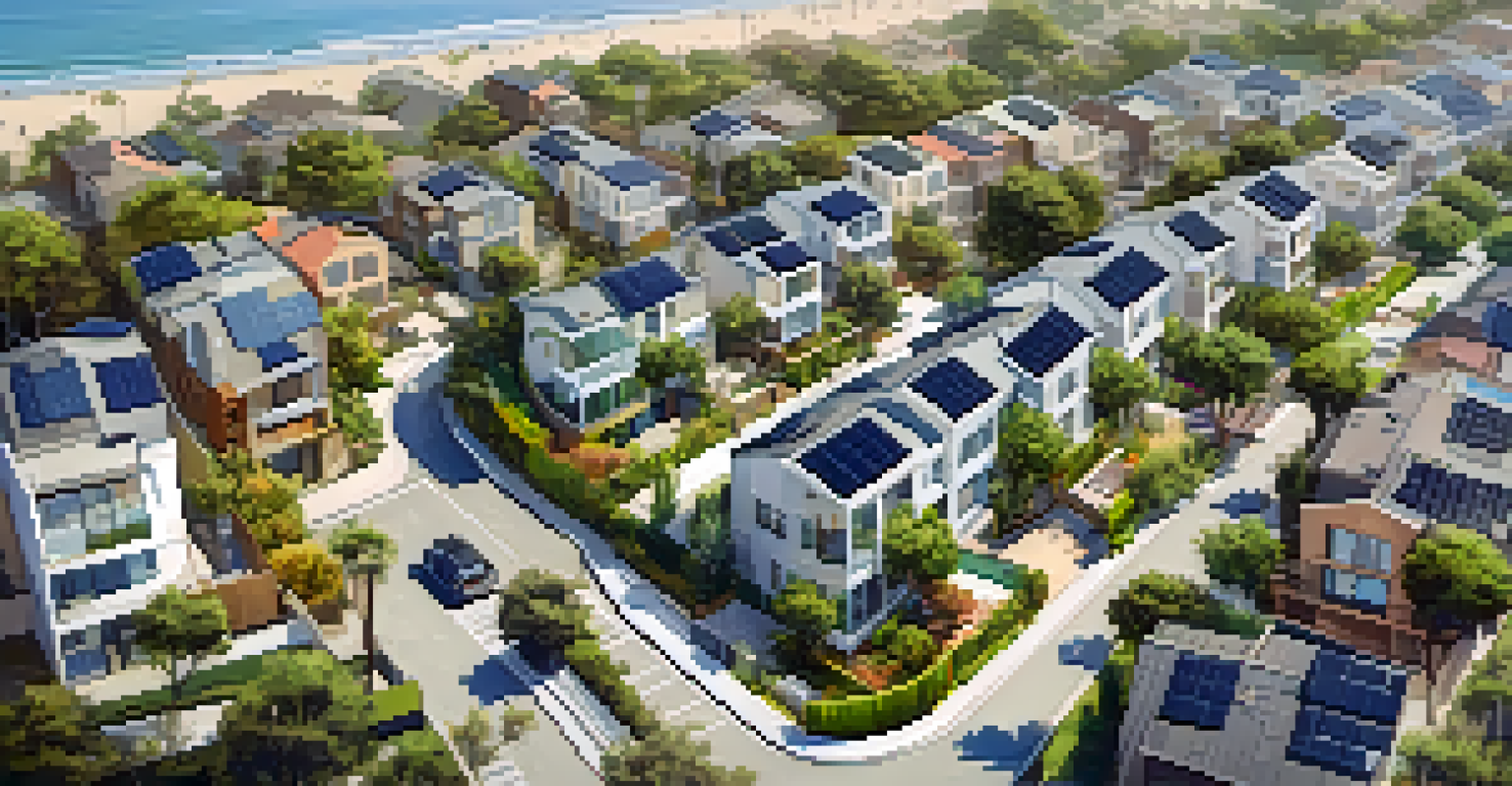Impact of Climate Change on Santa Monica Real Estate Trends

Understanding the Climate Change Challenge in Santa Monica
Santa Monica, known for its beautiful beaches and vibrant community, is not immune to climate change. Rising sea levels, increasing temperatures, and more frequent wildfires are posing significant challenges. These environmental shifts are prompting residents and investors to rethink property values and location desirability.
The greatest threat to our planet is the belief that someone else will save it.
The city’s location along the Pacific Coast makes it particularly susceptible to flooding and erosion, which can directly impact real estate prices. Homebuyers are increasingly considering these factors when making purchasing decisions. As a result, the demand for properties in safer, less vulnerable areas is on the rise.
Local government initiatives are also focusing on sustainable development to mitigate these effects. Policies aimed at enhancing coastal resilience and promoting green building practices are becoming common. Understanding these dynamics is essential for anyone looking to navigate the Santa Monica real estate market.
Impact of Rising Sea Levels on Property Values
One of the most direct impacts of climate change is the threat of rising sea levels, which is especially pertinent for coastal cities like Santa Monica. Properties situated near the beach are becoming riskier investments as the potential for flooding increases. This threat has led to a noticeable shift in property values and buyer preferences.

Homebuyers are becoming more cautious, often opting for homes located further inland or in higher elevations. This shift is reflected in real estate trends, where properties with coastal views may see a decline in value, while inland properties gain popularity. The fear of future flooding is driving a reevaluation of what constitutes a 'desirable' location.
Climate Change Affects Property Values
Rising sea levels and environmental risks are prompting buyers to reconsider property investments in Santa Monica.
Real estate agents are advising clients to consider the long-term implications of climate change on their investments. Buyers are increasingly seeking properties with flood defenses or those that are part of community resilience plans. Understanding these trends is crucial for both buyers and sellers in the current market.
Shifts in Buyer Preferences and Demographics
As climate change continues to influence Santa Monica's real estate landscape, buyer preferences are evolving. Many prospective homeowners are now prioritizing sustainability and resilience in their home choices. Features like energy-efficient systems, drought-resistant landscaping, and proximity to green spaces are increasingly desirable.
Climate change is no longer some far-off problem; it is happening here, it is happening now.
Younger buyers, in particular, tend to value eco-friendly living options and are often willing to pay a premium for homes with sustainable features. This demographic shift is changing the types of properties that are in demand and, consequently, what developers are focusing on. The push for greener living is reshaping the market significantly.
Moreover, communities are coming together to advocate for more sustainable practices, further influencing buyer preferences. Neighborhoods that prioritize eco-conscious developments are becoming more attractive. This trend highlights the importance of community engagement in shaping real estate dynamics amidst climate challenges.
The Role of Local Government in Real Estate Trends
Local government initiatives play a crucial role in shaping real estate trends in Santa Monica. The city has been proactive in addressing climate change through various policies aimed at enhancing resilience. These initiatives can significantly influence property values and buyer confidence in the area.
For instance, investments in flood control infrastructure and zoning regulations that promote sustainable building practices are becoming increasingly important. By prioritizing these measures, the government is not only protecting its residents but also stabilizing the real estate market. Homebuyers are more likely to invest in areas where they feel secure from environmental risks.
Sustainability Drives Buyer Preferences
Homebuyers are increasingly prioritizing eco-friendly features and resilient neighborhoods in their property searches.
Furthermore, community engagement in these initiatives fosters a sense of shared responsibility. When residents feel their local government is taking action, it can enhance overall market confidence. This partnership between the government and community is vital for sustaining Santa Monica's real estate appeal.
Insurance and Its Changing Landscape in Real Estate
Climate change is also impacting the insurance landscape for Santa Monica homeowners. As the risk of natural disasters rises, insurance companies are reassessing the risks associated with properties near the coast. This has led to higher premiums and, in some cases, difficulty obtaining coverage for certain homes.
Homebuyers must now factor in insurance costs when considering a property, which can influence their purchasing decisions. Properties located in high-risk zones may become less attractive due to the increased financial burden of insurance. This shift is reshaping the overall market dynamics in Santa Monica.
Additionally, some homeowners are taking proactive measures to safeguard their investments by investing in flood mitigation strategies. These efforts can potentially lower insurance costs and enhance property value. Understanding how insurance trends are evolving in response to climate change is crucial for anyone navigating Santa Monica's real estate market.
The Future of Rental Properties in Santa Monica
With the impacts of climate change becoming more pronounced, the rental market in Santa Monica is also adapting. Landlords are increasingly aware of the need to offer properties that meet new sustainability standards. This shift is influencing what renters are looking for in their next home.
Renters are now prioritizing energy-efficient appliances, sustainable building materials, and properties located in resilient neighborhoods. This demand is pushing landlords to invest in upgrades that not only attract tenants but also align with eco-friendly practices. As a result, rental prices in sustainable buildings may see a boost.
Government Initiatives Shape Market
Local government policies aimed at enhancing climate resilience are influencing property values and buyer confidence.
Moreover, the rise of remote work is also changing the rental landscape. With more people seeking flexible living arrangements, there is an uptick in demand for rental properties that offer both comfort and sustainability. Adapting to these evolving preferences is essential for landlords looking to thrive in the changing market.
Long-Term Implications for Real Estate Investors
For real estate investors, understanding the long-term implications of climate change is vital. Making informed decisions about property purchases requires a comprehensive analysis of environmental risks and potential returns. Investors must consider how climate change can affect property values in the years to come.
Investing in properties that are equipped for climate resilience can provide a competitive edge. Properties with sustainable features are likely to maintain value even as climate-related challenges arise. This foresight can significantly impact an investor's portfolio in Santa Monica's shifting real estate market.

Additionally, being proactive in addressing climate risks can enhance an investor's reputation in the community. Those who prioritize sustainability not only contribute to environmental protection but also attract like-minded tenants and buyers. This approach fosters a more resilient and thriving real estate investment strategy.